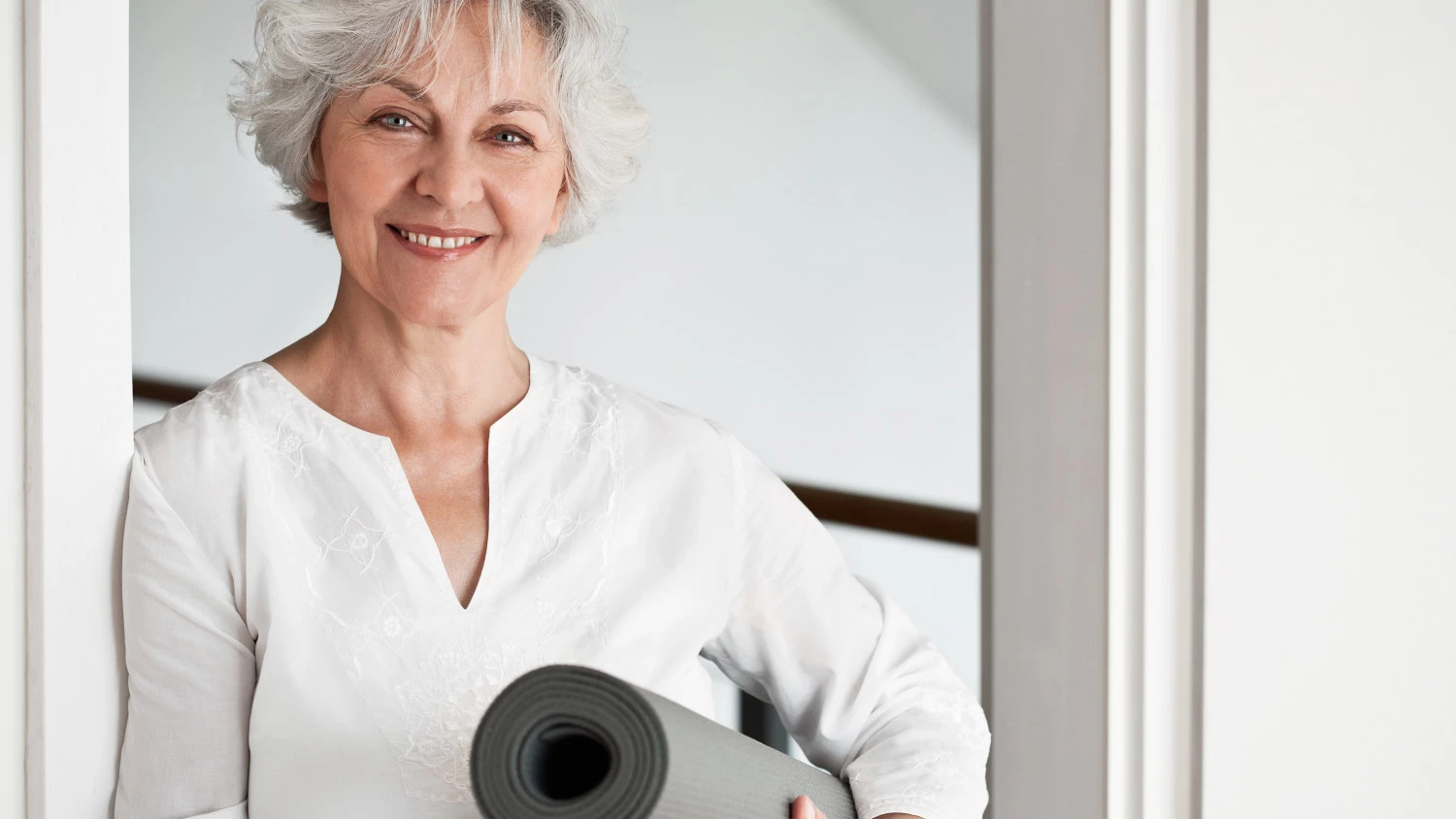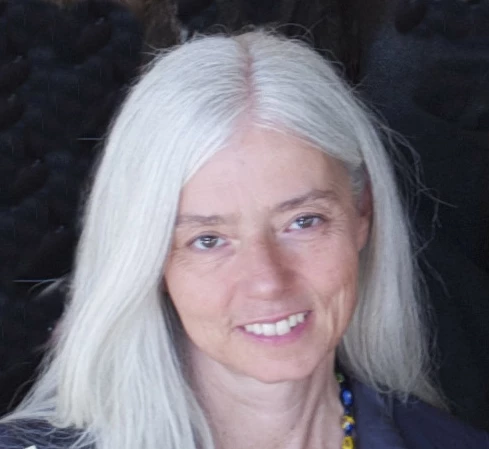Body-Positive Yoga: The Aging Body in Yoga

I found my first grey hair when I was 22. It wasn’t completely shocking. My mother’s hair was “brindled” grey-black for as long as I could remember before it transitioned to luminous white.
I never thought seriously about dyeing it. I knew it was an option, of course. Many of my friends were coloring their hair by their mid-30s and encouraging me to do the same. I just didn’t want to put chemicals on my head and couldn’t think of reasons to do it that outweighed the reasons not to.
That led to my questioning the pervasive cultural denial of and aversion to aging. It shows up everywhere, probably even more so now because we Boomers are taking over senior territory. For most of our lives, we’ve dominated popular culture, and we don’t seem to be giving that up easily. In large part, we’re not quite ready to use the “s” word (senior) to describe ourselves. Most of us Boomers remember The Who’s famous declaration: “Hope I die before I get old.”
We’re not the first aging-averse generation though. In my lifetime it has always been rude to ask adults their age. I know a spry 96-year-old that swears to people that she’s in her early 70s. Every decade we pass—40, 50, 60, 70 and beyond—is marked by greater shame.
Yes, shame. We’re conditioned to feel bad for … well … not having died yet.
What is a Yoga Body?
Yoga culture is not beyond this. Despite declarations that, “we are not our bodies,” what our bodies look like seems to be of paramount importance in yoga culture. Selfies of fancy poses, performed to perfection by mostly young, svelte, mostly scantily and fashionably clad, white women dominate social media. While these photos may be pleasing and even impressive to look at, their demographic does not represent the population at large or even the majority of people practicing yoga. They may draw some people to practice who aspire to look like these models. They may also scare people away, when they misinterpret yoga as being available only to those who are young, thin, fashionable and impossibly bendy.
The good news is that conversation around body positivity is growing. It’s been bubbling under the surface for a long time, mainly in the yoga blogging world. Even mainstream publications have dipped a toe into the conversation. I’m very encouraged by this development. I think it’s a huge step in the right direction.
What Happened to the Boomers?
But this is one area where the voices of the Boomer generation have been largely silent—or perhaps silenced. With few exceptions, the term “body-positive yoga” has been used to encourage inclusiveness in body size and shape. Those whose bodies are entering senior status have largely been left out of the discussion.
When did the system of Yoga begin to espouse the philosophy of youth over experience? When did Yoga adopt the idea that once your body begins to age that your mind, heart and accumulated experience become irrelevant? And why are we made to feel ashamed of the inevitable, even beautiful, process of growing deeper, wiser and more equanimous just because our bodies no longer fit into a shallow, limited and completely arbitrary cultural idea of beauty?
My theory is this: We are a body-oriented culture. We are our bodies. Our bodies are our Selves. We judge ourselves by our appearance and our body’s ability to perform. When our bodies change—as they inevitably do—our self-worth goes with them, for better or for worse.
When the prince, Siddhartha, ventured out of his palace for the first time, he was shaken by his first glimpses of a person bent with age, a person wracked with illness and the body of a person who had died. Seeing the inevitable path of all our bodies to our final demise caused him to inquire into how he might transcend the suffering he had witnessed. This led him to realize that in order to transcend suffering, he had to transcend his attachment to and identification with the body. He had to look deeper, beyond the pleasures and suffering of the body, for lasting happiness.
This is what our yoga practice is about. The squabbling about what is or is not the perfect yoga body has absolutely nothing to do with Yoga. Any person in a body who is practicing Yoga is living in a yoga body, regardless of age, build, gender or flexibility. And the deeper practices at the heart of Yoga—meditation—require a body simply as an anchor for awareness.
This is not to say that our bodies are not worth appreciating. They are infinitely worthy of our appreciation. My takeaway from three semesters of anatomy training is pure amazement at the elegant design of these vehicles in which we travel. That design is not a mistake. Nor is our genetically determined build, height, skin color, hair color and joint flexibility. And aging is not a mistake. We can take good care of our bodies so that we live more comfortably in them, but we can’t stop the aging process. It happens to all of us if we are lucky enough to live into old age.
Practicing asana is an intelligent and inspiring way to keep our bodies balanced and happy. Tending to our bodies mindfully, and with love and appreciation, cultivates a sense of grace that permeates not only our meditation, but the whole of our lives.
So please, give this body, the one you’re living in right now, a little appreciation for having gotten you this far into your life. Know that it will change, and that you can grow with those changes. Know that aging brings riches you can’t fathom when you are young. Yes, there are tradeoffs. While I might wish I had the hip joints of my 30s, I’m very happy to living in the mind and heart of my 50s.
Love your body. Love your mind. Love your heart. Ride their evolution with curiosity and delight.
Study and be inspired; more on mindfulness from YogaUOnline and Ana Forrest: Yoga of Mindful Eating – Fierce Medicine for Healing Your Spirit.
Practice tips for healthy aging with YogaUOnline and Baxter Bell, MD on our Yoga Practice Channel.
Printed with permission from HuggerMugger.com
 Charlotte Bell began practicing yoga in 1982 and began teaching in 1986. She was certified by B.K.S. Iyengar in 1989 following a trip to Pune. In 1986, she began practicing Insight Meditation with her mentors Pujari and Abhilasha Keays. Her asana classes blend mindfulness with physical movement. Charlotte writes a column for Catalyst Magazine and serves as editor for Yoga U Online. She is the author of two books: Mindful Yoga, Mindful Life and Yoga for Meditators, both published by Rodmell Press. She also edits Hugger Mugger Yoga Products¹ blog and is a founding board member for GreenTREE Yoga, a non-profit that brings yoga to underserved populations. A lifelong musician, she plays oboe and English horn in the Salt Lake Symphony and the folk sextet Red Rock Rondo whose 2010 PBS music special won two Emmys.
Charlotte Bell began practicing yoga in 1982 and began teaching in 1986. She was certified by B.K.S. Iyengar in 1989 following a trip to Pune. In 1986, she began practicing Insight Meditation with her mentors Pujari and Abhilasha Keays. Her asana classes blend mindfulness with physical movement. Charlotte writes a column for Catalyst Magazine and serves as editor for Yoga U Online. She is the author of two books: Mindful Yoga, Mindful Life and Yoga for Meditators, both published by Rodmell Press. She also edits Hugger Mugger Yoga Products¹ blog and is a founding board member for GreenTREE Yoga, a non-profit that brings yoga to underserved populations. A lifelong musician, she plays oboe and English horn in the Salt Lake Symphony and the folk sextet Red Rock Rondo whose 2010 PBS music special won two Emmys.



